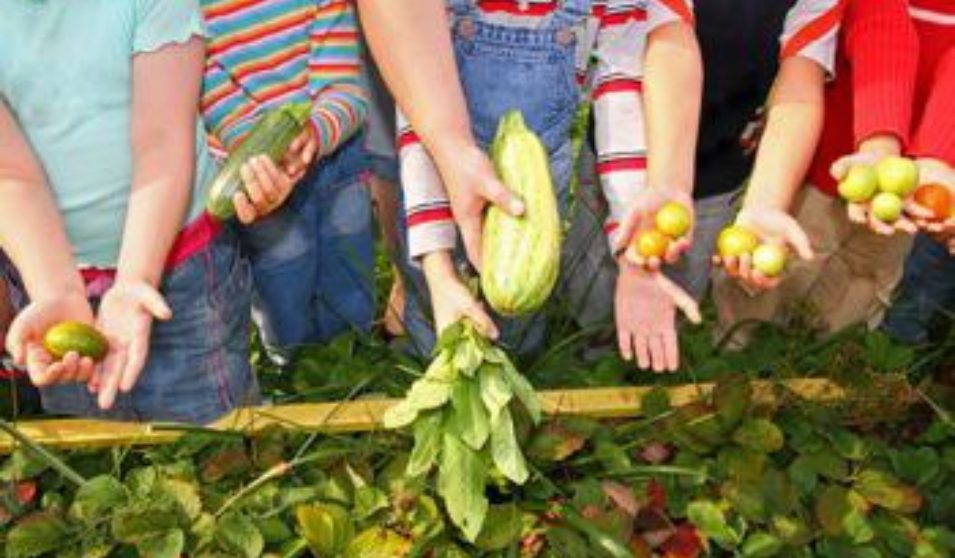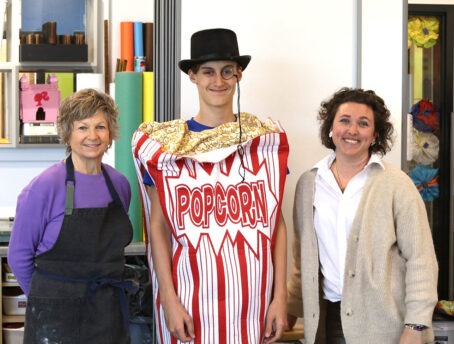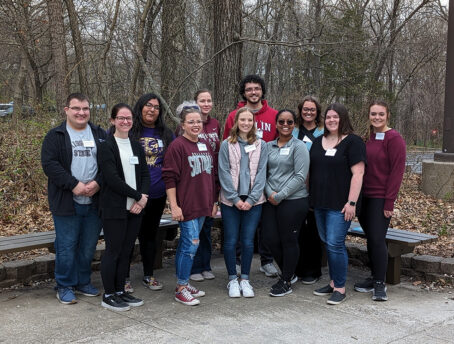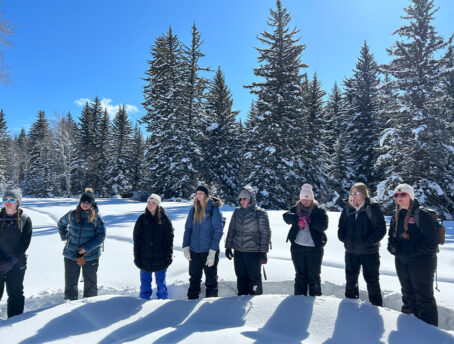Editor's note: Clay Forsberg is a Montana blogger who lives in a small, rural community. He considers himself a "solutionist," and if you spend some time on his website you will see why. Thanks to Clay for sharing this essay, which was originally posted in February of this year. Clay has more than 2,000 followers at his Twitter account: @clayforsberg. Mr. Forsberg's views are his own and do not necessarily reflect the views of the Rural Schools Collaborative. The Rural Schools Collaborative encourages iconoclastic thinking, and we love to share your ideas!
Farm-to-School-to-Market: Cross Generational Rural Synthesis, by Clay Forsberg
A couple of days ago I was having a Twitter discussion with Sandra, from Nebraska. Sandra is hard-core in the ‘farm-to-school’ movement. Actually it really shouldn’t even be called a movement since it’s just common sense. She posted an article from NPR discussing the fact that revenue from farmers markets nationwide have more or less peaked and in some locals even declined. There are areas that are still seeing increases, but overall the trend is not what you’d expect considering all the publicity of the last few years.
The article detailed several of possible causes. According to Sarah Low, a USDA economist and lead author on the report; “Farmers are increasingly using middlemen to sell to restaurants, grocery stores and distributors. With an increasing share of their produce, dairy or meat going to those channels, some farmers may choose to forgo the farmers market.” Simply put, the farmers market phenomenon may just be ‘growing up.’
However there was one quote that caught my attention.
“It’s just not as cost-effective for producers to be face-to-face with consumers,” Low says. “A lot of farmers like to spend their time farming, not necessarily marketing food.”
Thinking about it, this makes sense. And taking it one step further – what if this reason is a major factor why there’s not more locally grown food available overall. This especially hits home with me. I live in a farming community outside of Billings, Montana. The farmers around here grow either corn or sugar beets if their land is irrigated, or barley and wheat if it’s not. And that’s it. Aside from an occasional ‘corn-on-the-cob,’ nothing grown in the fields here make it to my table.
I have a small garden and grow herbs, kale, tomatoes, carrots, etc. And they all grow very well. Yet our local farmers don’t grow any of this, and most don’t people in my town don’t even know what kale is. I know since I give away a lot of it. Their crops are put in big trucks and driven to processing plants owned by multinational corporations headquartered in lands far removed from this little farming town.
But what if the farmers had another option, an option where they didn’t have to spend their time marketing to and groveling in front of those picky consumers looking for ingredients for their next caesar salad or Chicken Florentine (just kidding).
Now on a different subject, but not really, as I’ll come back to this in a minute: My town has a big generational gap. I’m not saying this divide is intentional, but rather I just don’t think there’s much contact between the teenagers and the retirees (or even just adults). And I guessing this might be the case in a lot a small towns and even big cities in America. We’ve always seen age divides, but with the advent of the diversion of personal technology, these chasms may be getting even wider. There seems little opportunity for common ground.
Schools are part of your community – and your community should be part of its schools
I believe a lot of this is the fault of schools. After all, aren’t schools responsible for developing the young talent that supposedly is the future for the community it serves? Yet how much connection is there actually made with its community? And yes schools are supposed to serve the community. The residents pay property tax to fund the schools. But schools are often viewed as the castle on the hill … including the moat. I’m not going so far to say there are crocodiles in the water under the drawbridge, but what hell. In some schools there might as well be. For example, in my little town, even my father, a high school teacher with 25+ years experience, is uncomfortable even going in the building. Here’s someone with a wealth of knowledge at their disposal he’s willing to share … and nothing. Yet they have no problem sticking their hands out asking for money for renovations to update a school that should be closed and consolidated with those of the neighboring towns.
But what if we could change this, especially in rural and farming communities. We have the perfect vehicle for it too … the farm.
Now, let’s get back to my previous point about farmers wanting to farm and not be marketers. After Sandra initially posted the NPR article I mentioned above, I tweeted back:
What about a middleman between farmer and a#farmersmarket handling marketing, packaging, distribution, etc.
And her response was:
One local farmer I know hires students from a nearby school to come out to help him get ready each season. Great experience.
And there was the synthesis that sparked the fire that created this piece and my ‘Farm-to-School-to-Market’ concept.
What if rural high schools and middle schools created programs where students could be the marketers for local farmers producing farmers market ready crops. Not only could the kids market the crops, they could handle the whole post-harvest process as fledging entrepreneurs. Heck they could even help with the harvest if need be. And why stop there, they could even work out co-op deals with the farmers helping grow the crops in the first place. And who says the Farmers Market has to be their only outlet for sales? The students could negotiate deals with local independent grocers and restaurants for additional revenue streams for their products.
I’m sure virtually all rural schools have Vo-Ag programs in their curriculum, but what I’m outlining here isn’t just a farm project. It’s a hands-on exercise in entrepreneurialism and business development. Imagine each school having several groups of students, each potentially spanning different grade levels – creating mini-produce companies. The students in each group would be responsible for all aspects of their micro business, possibly even working with the farmer for crop selection down to the branding and packaging of their product. They would also determine where they would sell them; retail through farmers markets, door-to-door in town, or contract out for wholesale (stores and restaurants). And who knows, maybe some enterprising group could create packaged products from their raw crops – like kale chips. Their options are limited only by their imaginations.
Each group would structure their company how they wanted and allocate duties and decision-making accordingly. Some members of the group may want to take on more responsibility and then be compensated accordingly. I want to note that ‘Farm-to-School-to-Market’ is not meant to be a school fundraiser. It’s the kids who are putting in the work, so they should be the ones who are rewarded financially. The school benefits by the fact that here’s a ready-made curriculum piece dropped in their lap that actually provides real-world benefit, unlike most activity associated with the dreaded standardized tests, so much in vogue.
Many aspects of ‘Farm-to-School-to-Market’ could be integrated directly into regular class activity, either as part of traditional instruction or as independent projects. Each student group would also have to keep an account of their experience with their company, probably through an online blog. Their ideas, tips and suggestions would also be included and shared as other ‘Farm-to-School-to-Market’ groups spread geographically and became commonplace in the rural eduction curriculum.
Students who attend schools with farm-to-school programs are 28% more likely to choose healthy food options. This is especially important given the recent findings showing that once a person becomes obese they will most likely fight obesity all their life, regardless of whether healthy eating and exercise routines are adopted. Anything that can be done at early ages to promote healthy eating, must be done. And imagine if these healthy eating habits were taken home as homework to benefit the whole family. But these farm-to-school programs can’t happen with just desire. They need a supply of healthy food. And that means local farmers raising it … the core tenet of ‘Farm-to-School-to-Market.’
Be part of making your community’s school a real world experience
America’s public schools are often accused of creating test-ridden robots of their students. Here’s a way to counter that accusation, and at the same time help bridge a generational divide all too prevalent in rural America. Combine this with helping seed and nurture a much-needed ‘farm-to-school’ movement … you have trifecta of benefits.
Rural America needs outlets for its young people. The best and brightest of these communities will go where they can express themselves creativity, artistically or through business endeavours. Whether they flex these creative muscles in the towns they grew up in is up to their communities and the metaphorical canvases they provide. Their home towns have the advantage. Retaining talent is a lot easier than attracting new. But make no mistake, having young talent is not an option for a community to flourish. It is mandatory.
Literally and figuratively … it’s on your plate. Now it’s up to you. Wake up your schools! After all … they are your schools.
______________________________________






